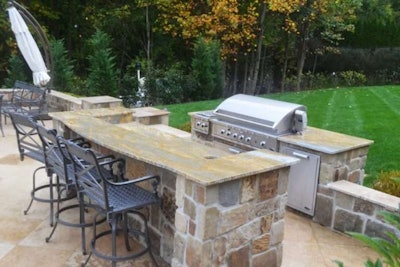
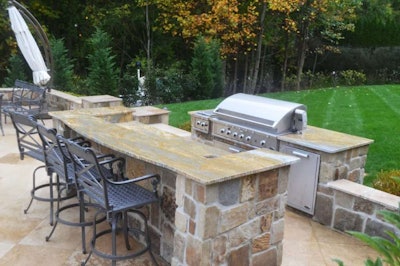 An outdoor kitchen built of natural stone with granite countertops.
An outdoor kitchen built of natural stone with granite countertops. Photo: Courtesy of RTK Design Group
Natural stone is durable, readily available and comes in a variety of textures and colors. No wonder it’s considered a darling among landscape architects and designers. For these reasons, and more, they often turn to natural stone when creating their designs, even when they have a wide range of materials at their disposal.
We dug deeper and asked three experts to share with us how and why they turn to natural stone for their projects. Some of the reasons might surprise you.
Natural stone is durable, versatile
“Great design is often centered around the structures and patterns created by elements like stone work,” says Robert Kaye, landscape architect and owner of New Jersey-based RTK Design Group. Kaye has spent the last 35 years working in all aspects of landscape design and construction, including teaching in academia.
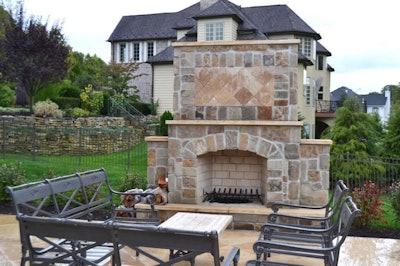 This outdoor fireplace was built of natural stone and decorated with a travertine mosaic inlay to create a one-of-a-kind look. Photo courtesy of RTK Design Group
This outdoor fireplace was built of natural stone and decorated with a travertine mosaic inlay to create a one-of-a-kind look. Photo courtesy of RTK Design Group“In order to create these beautiful patterns, the stones must be cut and shaped perfectly,” Kaye adds. “With cultured stone, this can be very difficult as the concrete aggregate begins to show through as you chip away at each piece. With natural stone, cutting and shaping it is not only possible, it often unearths even more of the stone’s natural beauty.”
Stone’s heft taps into our need to feel grounded and safe. Jan Johnsen, co-principal of Johnsen Landscapes & Pools, works primarily with clients on the East Coast and has more than 30 years of experience in landscape design and building. She appreciates stone for its useful durability. Part of its appeal, Johnsen says, is that stone is a steadying, grounding force in a landscape.
She often uses the material for its rustic beauty and ability to be molded into many things, from a solitary garden feature to a mosaic wall or quiet dry stream.
Larry Cavender, ASLA, a landscape architect based in Portland, Oregon, often uses natural boulders in his projects because they’re great at handling grade changes in the garden.
“Well-placed boulders create interest and strength that no other material can match,” he says.
Natural stone is abundant and rich
Unlike other building materials that have to be fabricated or produced using harsh chemicals, natural stone is abundant in quantity, bountiful in colors and designs and eco-friendly.
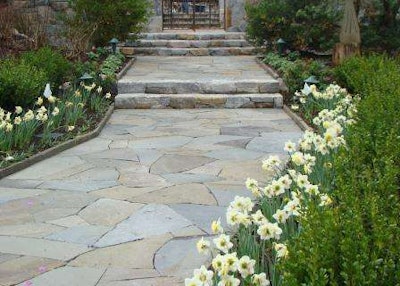 Stone paving set in a random pattern makes a great garden walk. Here it is bordered by low bluestone edging.
Stone paving set in a random pattern makes a great garden walk. Here it is bordered by low bluestone edging.Design and installation by Jan Johnsen, Johnsen Landscapes & Pools.
“Natural stone, as its name expresses, is just that: acquired from nature,” notes Kaye.
He agrees with Johnsen’s sentiment about feeling grounded but also notes that natural stone is a physically strong material and made to withstand the elements.
“It won’t fade or change color over time,” he adds. “It wears beautifully and will continue to do so as it’s used and loved outside the home.”
For clients who want to achieve an authentic, rich look, natural stone is the way to go.
“As natural stone is extracted directly from the great outdoors, it allows for a landscape design to easily emulate nature, often creating the most serene space,” Kaye says. “When I design, I want the spaces I create to exude both luxury and tranquility. Natural stone allows me to achieve that balance.”
Cavender’s local stone yards and quarries offer diversity and richness in stone products that allows him to choose materials that complement other landscape and architectural features within the garden.
Since there is a range of natural stone options, from local quarries to international sources, it can also be as affordable or extravagant as budgets and designs demand.
Natural stone is visually appealing in landscapes
The beauty that natural stone affords in projects is that the material is beautiful and can be used in so many different ways to create texture and interest. Sometimes finding that perfect stone can make the space come alive.
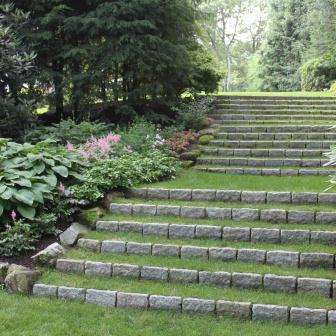 Curving grass steps add an elegant accent to a sloping garden. Belgian Block act as the step risers. Design and installation by Jan Johnsen, Johnsen Landscapes & Pools.
Curving grass steps add an elegant accent to a sloping garden. Belgian Block act as the step risers. Design and installation by Jan Johnsen, Johnsen Landscapes & Pools.Johnsen often finds tall vertical stones in her local stone yard that she enjoys using as accents in her projects, such as standing stones in a garden.
She often uses stone to create garden steps because it makes the journey through the garden a special experience.
“I love to use stone – granite pavers, Belgian blocks or bluestone – as the risers in grass steps,” Johnsen adds.
Cavender appreciates how natural stone can be an interesting counterpoint or contrast to more refined landscape elements, creating an interesting tension within the landscape.
An overriding theme among our experts on why they love using natural stone in their landscape design projects is it often allows artistic liberties unlike other types of materials or treatments available in the marketplace. From walls and flooring to water and garden features, natural stone allows a homeowner and designer the opportunity to experiment with using different types of stones within the landscape in unique ways.
“Stone is a premium material and brings a higher value to the overall project,” adds Cavender. He and his client also like the fact that it’s a natural material that makes a strong connection back to nature.
Along with its ability to be formed into different shapes and sizes, as well as its obvious aesthetic appeal, natural stone is chosen by landscape architects and designers for its variety, wide range of price points and its unique power to enrich their designs.
EDITOR’S NOTE: This article was written by Megy Karydes. Karydes is a Chicago-based writer whose work has appeared in USA Today, Forbes, Chicago Tribune and Midwest Living, among others. Find her at MegyKarydes.com. She prepared this article for MIA+BSI: The Natural Stone Institute.










